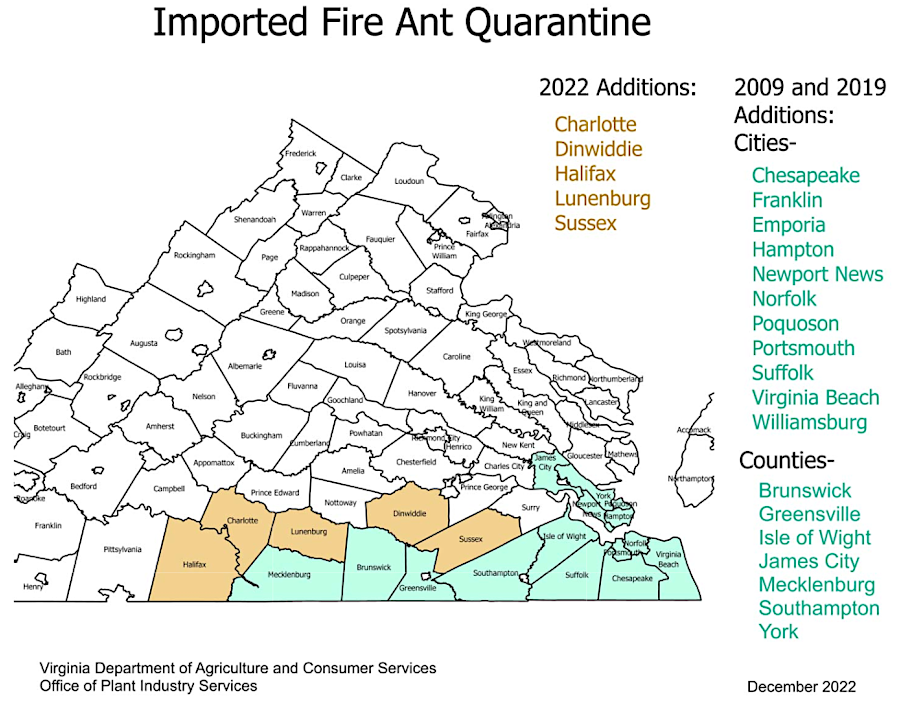
the quarantine zone for fire ants was expanded again in 2022
Source: Virginia Department of Agriculture and Consumer Services (VDACS), Imported Fire Ant

the quarantine zone for fire ants was expanded again in 2022
Source: Virginia Department of Agriculture and Consumer Services (VDACS), Imported Fire Ant
Red imported fire ants (Solenopsis invicta) reached the Gulf Coast states from South America first, then expanded their range over several decades. They are aggressive invertebrates with a venomous sting that creates a burning sensation.
Fire ants are not a major pest in their native range. One natural control is a Brazilian phorid fly. It parasitizes fire ant larvae and forces the worker ants to hide, reducing food gathering and weakening the colony.
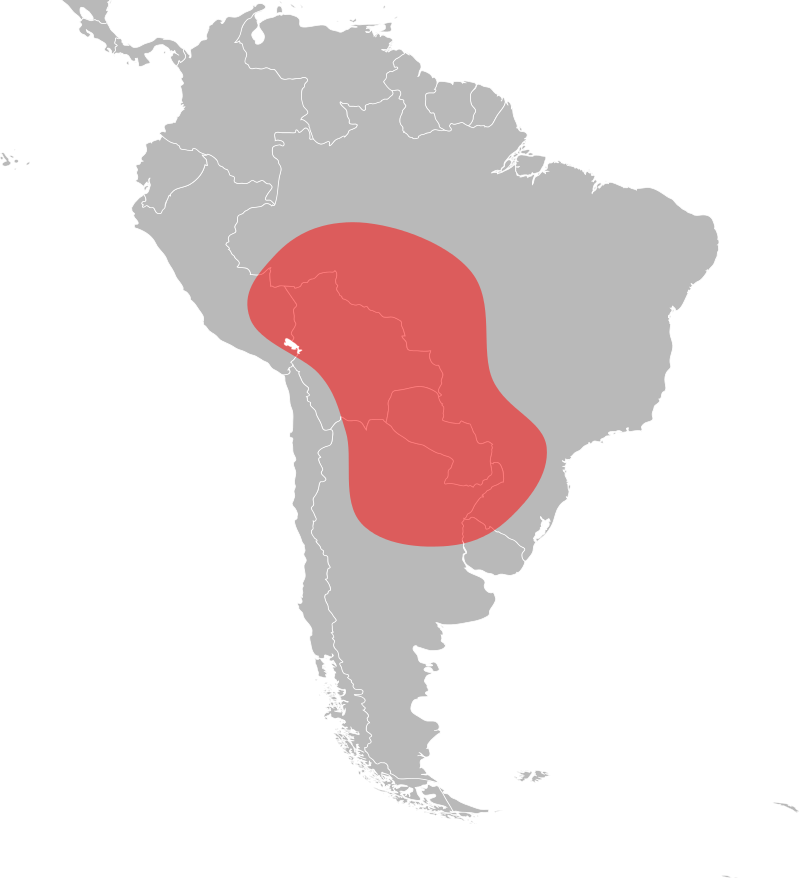
the native range of fire ants (Solenopsis invicta) is in South America
Source: Wikipedia, Red imported fire ant
In North America fire ants are a painful nuisance to animals, dogs, cattle, and other animals as well as humans. Fire ants feed on the young of ground nesting birds, and can cause calves to be blinded.
Fire ants build mounds in order to escape saturated soil in the winter. Those mounds are a headache for farmers moving equipment through fields.
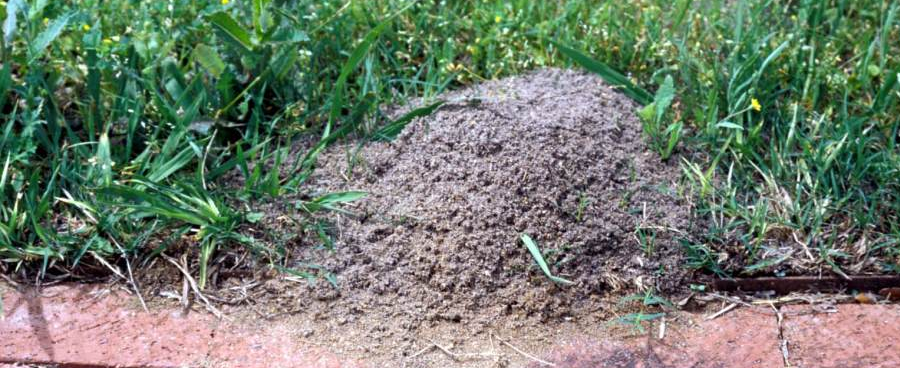
fire ant mound
Source: Texas A&M AgriLife Extension, Fire Ants - Let Them Eat Bait
The invasive species reached Hampton Roads in 1989. The expectation was that fire ants might be transported widely by movement of nursery stock and sod as well as vehicles that park near a fire ant mound, but the range of the fire ant would be limited by cold weather. They were thought likely to infest the Eastern Shore and much of Tidewater and part of Southside Virginia, but not become common in the Shenandoah Valley or Northern Virginia.
A 2009 quarantine by the Virginia Department of Agriculture and Consumer Services did not stop the fire ants from expanding into Brunswick, Mecklenburg and Halifax counties by 2017, then north to Petersburg and west all the way to Lee County. In 2022, the quarantine zone was expanded to include 12 counties and 11 independent cities. Fire ant mounds were discovered in Danville's Angler Park in 2022, but the city was not included - yet - in the quarantine zone.
By 2023, fire ants were present in Richmond and Hanover County. In 2025, the quarantine area was expanded again to include Chesterfield, Lee, Nottoway, Pittsylvania, Prince George, and Surry counties plus the independent cities of Colonial Heights, Danville, Hopewell, and Petersburg.
Outside the quarantine area, state personnel will try to destroy fire ant mounds. Within the boundaries of the quarantine area, landowners are welcome to control the ants but the state will no longer invest the effort.
The ants found in Lee County were hybridized fire ants, descended from both red and black imported fire ants. They were more suited to cooler climates. According to a Virginia Tech entomologist, the range expansion appears related to a warming climate:1
Ant-killing baits are not authorized in farm fields or pastures, in order to keep the chemicals out of the food supply for humans.
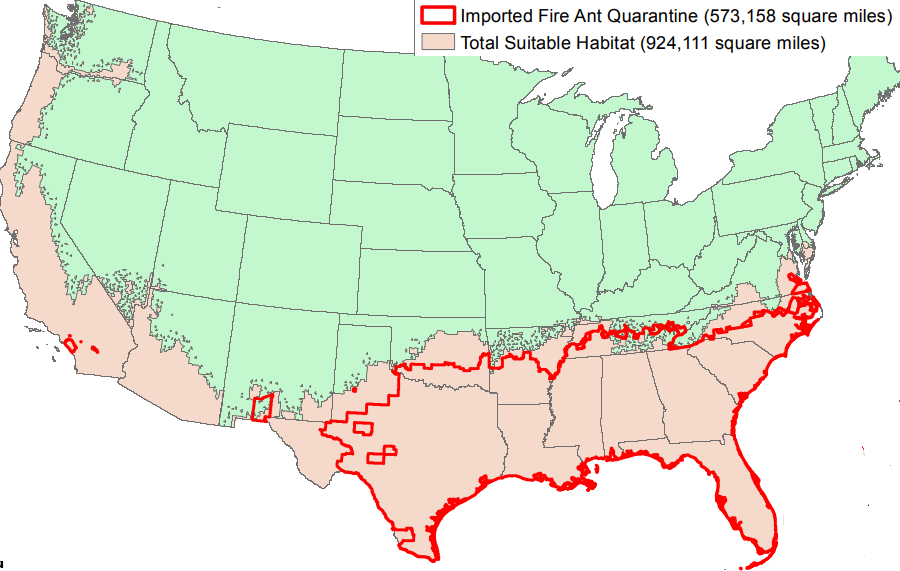
with a warmer climate, fire ants can expand further into Virginia
Source: US Department of Agriculture, Suitable Habitat for Imported Fire Ant Colonization Under Natural Rainfall and Irrigated Conditions
The arrival of non-native fire ants has triggered an evolutionary change in eastern fence lizards (Sceloporus undulatus). The immune systems of lizards have developed antibodies that neutralize the venom toxins of the ants. That change may be associated with adults consuming fire ants as a new food source.
Adult lizards typically respond to threats by lying flat and trying to blend in with the landscape. That passive behavior allows fire ant scouts to recruit others and inject enough venom with their stingers to kill a lizard. Where the ranges of eastern fence lizards and fire ants overlap, the lizard population has developed longer legs. Longer legs are useful in flicking off the scout ants and avoiding a lethal attack, but it breaks the camouflage used by lizards to hide from other predators.2
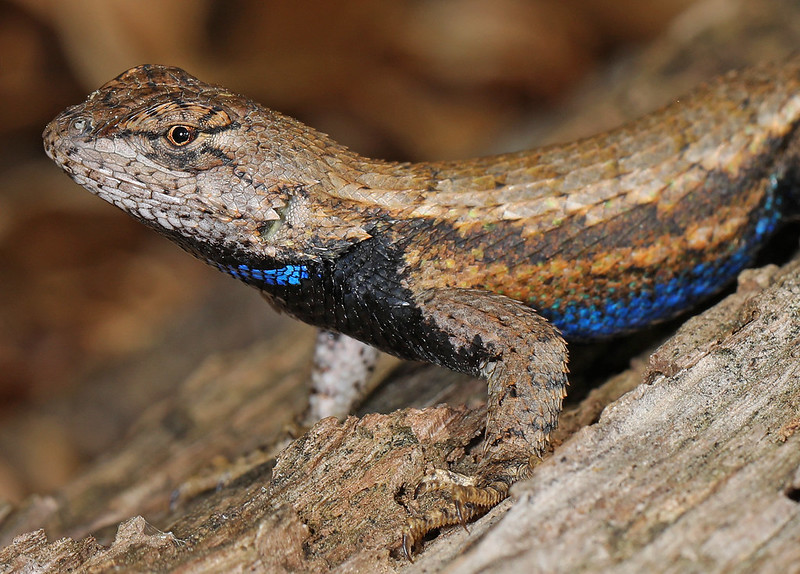
non-native fire ants have triggered evolutionary changes in eastern fence lizards (Sceloporus undulatus)
Source: Judy Gallagher, Eastern Fence Lizard - Sceloporus undulatus, Meadowood SRMA, Mason Neck, Virginia
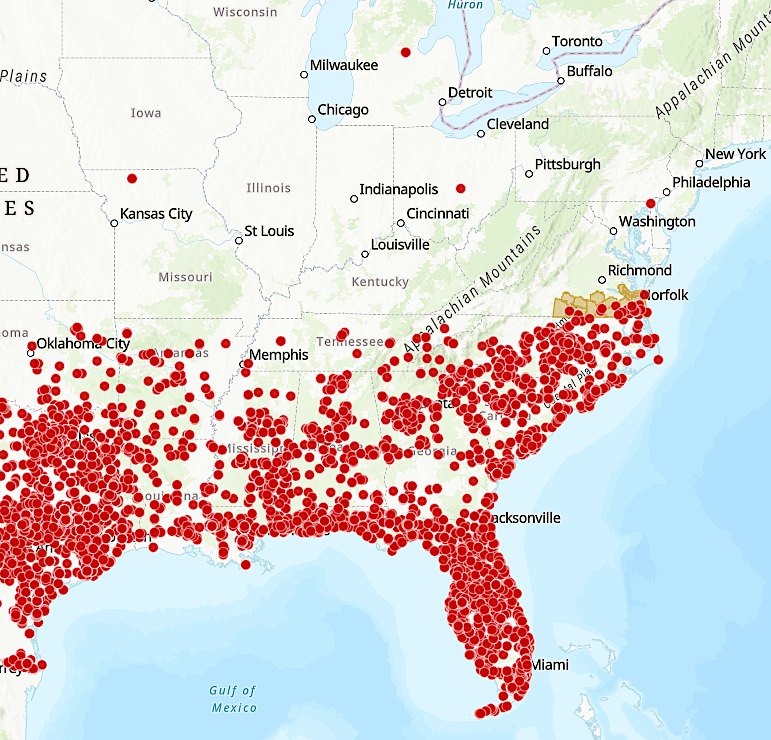
fire ant spread by 2023
Source: Virginia Invasive Species, Imported Fire Ant

fire ant quarantine zone in 2025
Source: Virginia Department of Agriculture and Consumer Services (VDACS), VDACS Announces Expansion of Virginia's Imported Fire Ant Quarantine (May 28, 2025)
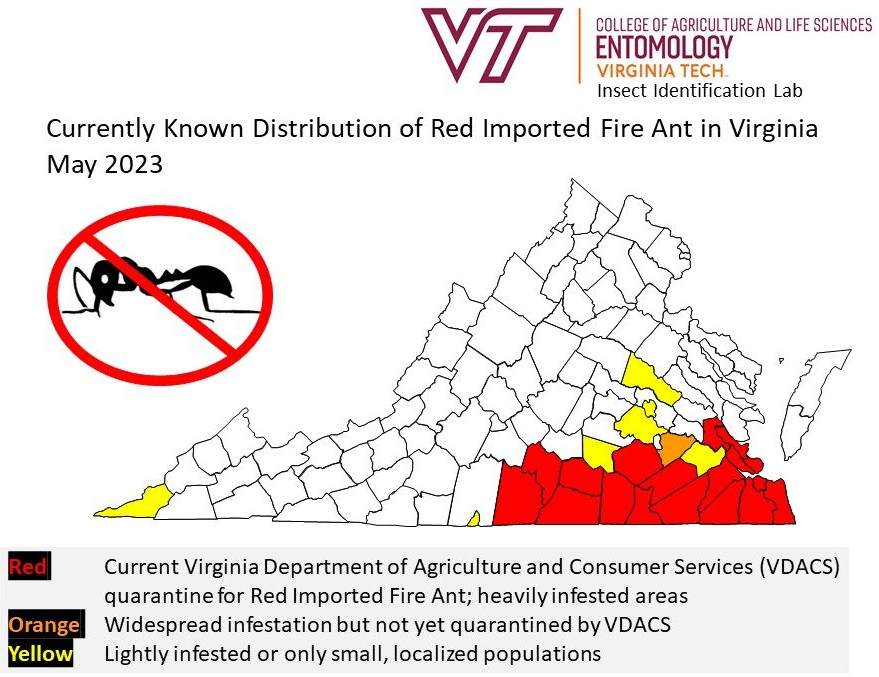
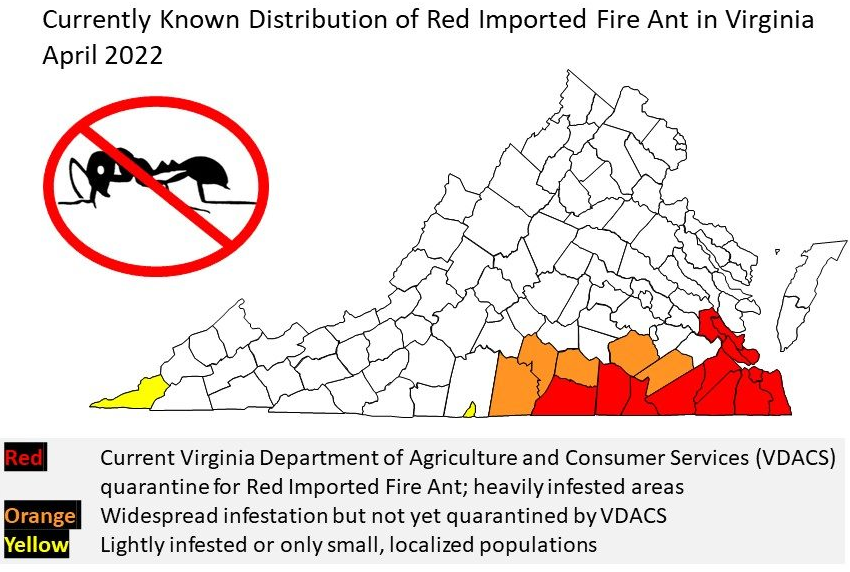
fire ants have expanded their range in Virginia as the climate has warmed
Source: Virginia Tech College of Agriculture and Life Sciences, Currently Known Distribution of Red Imported Fire Ant in Virginia
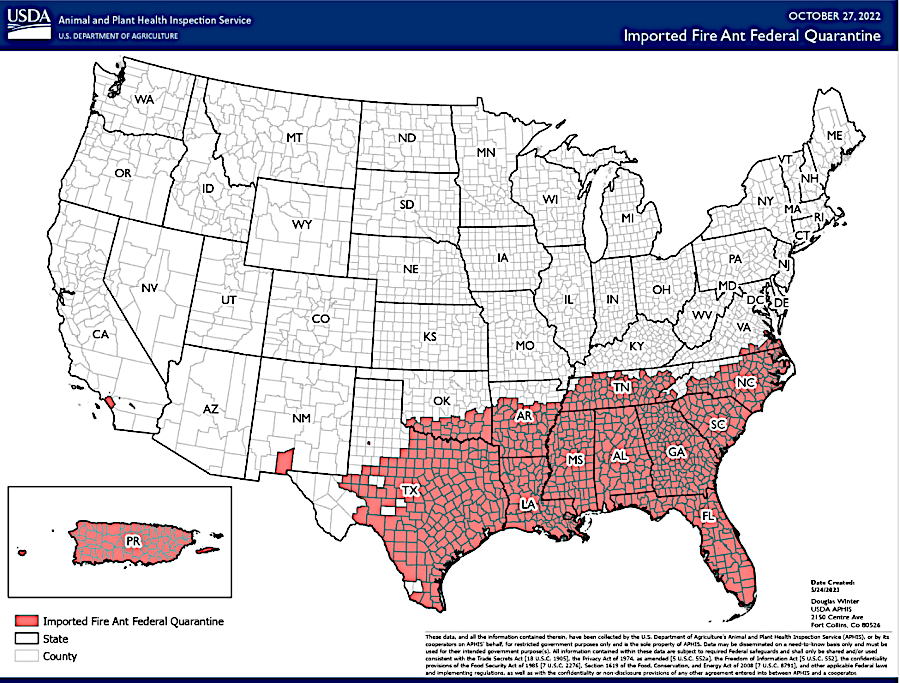
Federal fire ant quarantine updates occur after Virginia acts to expand its boundaries
Source: Animal and Plant Health Inspection Service, Imported Fire Ants